AMD's Radeon HD 5870: Bringing About the Next Generation Of GPUs
by Ryan Smith on September 23, 2009 9:00 AM EST- Posted in
- GPUs
Eyefinity
Somewhere around 2006 - 2007 ATI was working on the overall specifications for what would eventually turn into the RV870 GPU. These GPUs are designed by combining the views of ATI's engineers with the demands of the developers, end-users and OEMs. In the case of Eyefinity, the initial demand came directly from the OEMs.
ATI was working on the mobile version of its RV870 architecture and realized that it had a number of DisplayPort (DP) outputs at the request of OEMs. The OEMs wanted up to six DP outputs from the GPU, but with only two active at a time. The six came from two for internal panel use (if an OEM wanted to do a dual-monitor notebook, which has happened since), two for external outputs (one DP and one DVI/VGA/HDMI for example), and two for passing through to a docking station. Again, only two had to be active at once so the GPU only had six sets of DP lanes but the display engines to drive two simultaneously.
ATI looked at the effort required to enable all six outputs at the same time and made it so, thus the RV870 GPU can output to a maximum of six displays at the same time. Not all cards support this as you first need to have the requisite number of display outputs on the card itself. The standard Radeon HD 5870 can drive three outputs simultaneously: any combination of the DVI and HDMI ports for up to 2 monitors, and a DisplayPort output independent of DVI/HDMI. Later this year you'll see a version of the card with six mini-DisplayPort outputs for driving six monitors.

It's not just hardware, there's a software component as well. The Radeon HD 5000 series driver allows you to combine all of these display outputs into one single large surface, visible to Windows and your games as a single display with tremendous resolution.
I set up a group of three Dell 24" displays (U2410s). This isn't exactly what Eyefinity was designed for since each display costs $600, but the point is that you could group three $200 1920 x 1080 panels together and potentially have a more immersive gaming experience (for less money) than a single 30" panel.
For our Eyefinity tests I chose to use every single type of output on the card, that's one DVI, one HDMI and one DisplayPort:
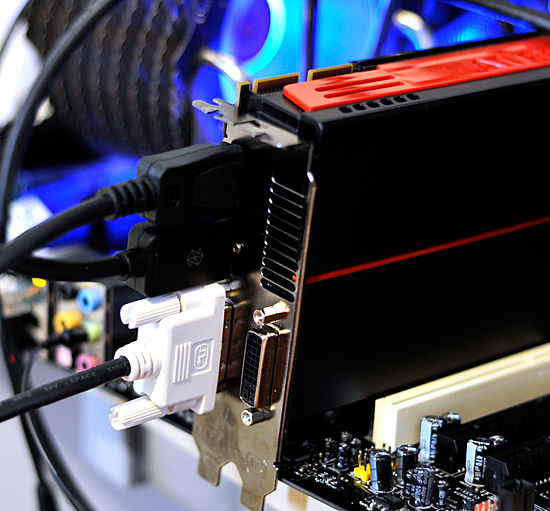
With all three outputs connected, Windows defaults to cloning the display across all monitors. Going into ATI's Catalyst Control Center lets you configure your Eyefinity groups:

With three displays connected I could create a single 1x3 or 3x1 arrangement of displays. I also had the ability to rotate the displays first so they were in portrait mode.

You can create smaller groups, although the ability to do so disappeared after I created my first Eyefinity setup (even after deleting it and trying to recreate it). Once you've selected the type of Eyefinity display you'd like to create, the driver will make a guess as to the arrangement of your panels.

If it guessed correctly, just click Yes and you're good to go. Otherwise ATI has a handy way of determining the location of your monitors:

With the software side taken care of, you now have a Single Large Surface as ATI likes to call it. The display appears as one contiguous panel with a ridiculous resolution to the OS and all applications/games:
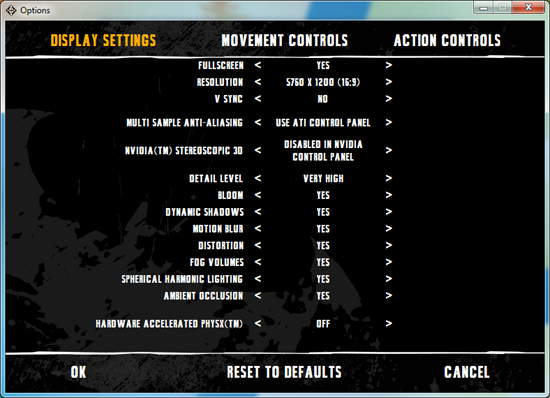
Three 24" panels in a row give us 5760 x 1200
The screenshot above should clue you into the first problem with an Eyefinity setup: aspect ratio. While the Windows desktop simply expands to provide you with more screen real estate, some games may not increase how much you can see - they may just stretch the viewport to fill all of the horizontal resolution. The resolution is correctly listed in Batman Arkham Asylum, but the aspect ratio is not (5760:1200 !~ 16:9). In these situations my Eyefinity setup made me feel downright sick; the weird stretching of characters as they moved towards the outer edges of my vision left me feeling ill.

Dispite Oblivion's support for ultra wide aspect ratio gaming, by default the game stretches to occupy all horizontal resolution
Other games have their own quirks. Resident Evil 5 correctly identified the resolution but appeared to maintain a 16:9 aspect ratio without stretching. In other words, while my display was only 1200 pixels high, the game rendered as if it were 3240 pixels high and only fit what it could onto my screens. This resulted in unusable menus and a game that wasn't actually playable once you got into it.
Games with pre-rendered cutscenes generally don't mesh well with Eyefinity either. In fact, anything that's not rendered on the fly tends to only occupy the middle portion of the screens. Game menus are a perfect example of this:
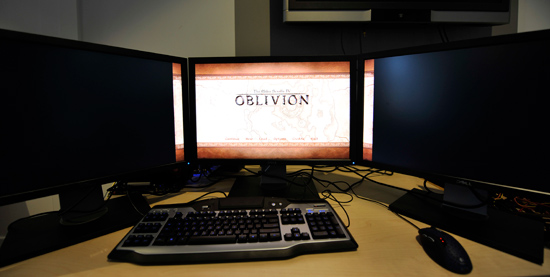
There are other issues with Eyefinity that go beyond just properly taking advantage of the resolution. While the three-monitor setup pictured above is great for games, it's not ideal in Windows. You'd want your main screen to be the one in the center, however since it's a single large display your start menu would actually appear on the leftmost panel. The same applies to games that have a HUD located in the lower left or lower right corners of the display. In Oblivion your health, magic and endurance bars all appear in the lower left, which in the case above means that the far left corner of the left panel is where you have to look for your vitals. Given that each panel is nearly two feet wide, that's a pretty far distance to look.
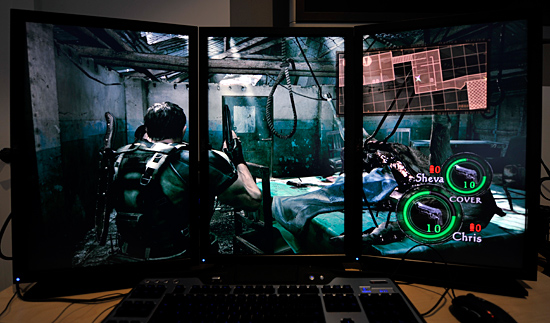
The biggest issue that everyone worried about was bezel thickness hurting the experience. To be honest, bezel thickness was only an issue for me when I oriented the monitors in portrait mode. Sitting close to an array of wide enough panels, the bezel thickness isn't that big of a deal. Which brings me to the next point: immersion.
The game that sold me on Eyefinity was actually one that I don't play: World of Warcraft. The game handled the ultra wide resolution perfectly, it didn't stretch any content, it just expanded my viewport. With the left and right displays tilted inwards slightly, WoW was more immersive. It's not so much that I could see what was going on around me, but that whenever I moved forward I I had the game world in more of my peripheral vision than I usually do. Running through a field felt more like running through a field, since there was more field in my vision. It's the only example where I actually felt like this was the first step towards the holy grail of creating the Holodeck. The effect was pretty impressive, although costly given that I only really attained it in a single game.
Before using Eyefinity for myself I thought I would hate the bezel thickness of the Dell U2410 monitors and I felt that the experience wouldn't be any more engaging. I was wrong on both counts, but I was also wrong to assume that all games would just work perfectly. Out of the four that I tried, only WoW worked flawlessly - the rest either had issues rendering at the unusually wide resolution or simply stretched the content and didn't give me as much additional viewspace to really make the feature useful. Will this all change given that in six months ATI's entire graphics lineup will support three displays? I'd say that's more than likely. The last company to attempt something similar was Matrox and it unfortunately didn't have the graphics horsepower to back it up.
The Radeon HD 5870 itself is fast enough to render many games at 5760 x 1200 even at full detail settings. I managed 48 fps in World of Warcraft and a staggering 66 fps in Batman Arkham Asylum without AA enabled. It's absolutely playable.
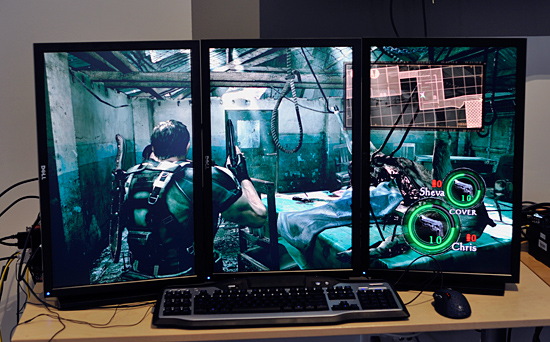










327 Comments
View All Comments
erple2 - Tuesday, September 29, 2009 - link
What the heck are you talking about? Are you saying that electricity consumed by a device divided by the "volume" of the device is the only way to measure the heat output of the device? Every single Engineering class I took tells me that's wrong, and I'm right. I think you need to take some basic courses in Electrical Engineering and/or Thermodynamics.(simplified)
power consumed = work + waste
You're looking for the waste heat generated by the device. If something can completely covert every watt of electricity that passes through it to do some type of work (light a light bulb, turn a motor, make some calculation on a GPU etc), then it's not going to heat up. As a result, you HAVE to take into consideration how inefficient the particular device is before you can make any claim about how much the device heats up.
I'll bet that if you put a Liquid Nitrogen cooler on every ATI card, and used the standard air coolers on every NVidia card, that the ATI cards are going to run crazy cooler than the NVidia cards.
Ultimately the temperature of the GPU's depends a significant amount on the efficiency of the cooler, and how much heat the GPU is generating as waste. My point is that we don't have enough data to determine whether the ATI die runs hot because the coolers are less than ideal, Nvidia ones are closer to ideal, the die is smaller, or whatever you have. You have to look at a combination of the efficiency of the die (how well it converts input power to "work done"), the efficiency of the cooler (how well it removes heat from it's heat source), and the combination of the two.
I'd posit that the ATI card is more efficient than the NVidia card (at least in WoW, the only thing we have actual numbers of the "work done" and "input power consumed").
Now, if you look at the measured temperature of the core as a means of comparing the worthiness of one GPU over another, I think you're making just as meaningful a comparison as comparing the worthiness of the GPU based on the size of the retail box that it comes in.
SiliconDoc - Friday, September 25, 2009 - link
You simply repeated my claim about watts, and replaced core size, with fps, and created a framerate per watt chart, that has near nothing to do with actual heat inside the die, since the SIZE of the die, vs the power traversing through it is the determining factor, affected by fan quality (ram size as well).Your argument is "framerate power efficiency", as in watts per framerate, and has nothing to do with core temperature (modified by fan cooling of course to some degree), that the article indeed posts except for the two failed ati cards.
The problem with your flawwed "science" that turns it into hokum, is that no matter what outputs on the screen, the HEAT generated by the power consumption of the card itself, remains in the card, and is not "pumped through the videoport to the screen".
If you'd like to claim "wattage vs framerate" efficency for 5870, fine I've got no problem, but claiming that proves core temps are not dependent on power consumption vs die size ( modified by the rest of the card *mem size/power useage/ and the fan heatsink* ) is RIDICULOUS.
---
The cards are generally equivalent manufacturing and component additions, so you take the wattage consumed (by the core) and divide by core size, for heat density.
Hence, ATI cards, smaller cores and similar power consumption, wind up hotter.
That's what the charts show, that's what should be stated, that is the rule, and that's the way it plays in the real world, too.
---
The only modification to that is heatsink fan efficiency, and I don't find you fellas claiming stock NVIDIA fans and heatsinks are way better than the ATI versions, hence 66C for NVIDIA, 75C, 85C, etc, and only higher for ATI, in all their cards listed.
Would you like to try that one on for size ? Should I just make it known that NVIDIA fans and heatsinks are superior to ATI ?
What is true is a lager surface area (die side squared) dissipates the same amount of heat easier, and that of course is what is going on.
ATI dies are smaller ( by a marked surface area as has so foten been pointed out), and have similar power consumption, and a higher DENSITY of heat generation, and therefore run hotter.
erple2 - Friday, September 25, 2009 - link
Oops, "milliwatt" should be "kilowatt". I got the decimal place mixed up - I used kilowatt since I thought it was easier to see than 0.247, 0.140, 0.137, 0.181...SiliconDoc - Wednesday, September 23, 2009 - link
Let's take that LOAD TEMP chart and the article's comments. Right above it, it is stated a good cooler includes the 4850 that ILDE TEMPs in at around 40C (it's actually 42C the highest of those mentioned)."The floor for a good cooler looks to be about 40C, with the GTS 250(39C), 3870(41C), and 4850 all turning in temperatures around here"
OK, so the 4850 has a good cooler, as well as the 3870... then right below is the LOAD TEMP.. and the 4850 is @ 90C -OBVIOUSLY that good cooler isn't up to keeping that tiny hammered core cool...
3870 is at 89C, 4870 is at 88C, 5870 is at 89C ALL ati....
but then, nvidia...
250, 216, 285, 275 all come in much lower at 66C to 85C.... but "temps are all over the place".
NOT only that crap, BUT the 4890 and 4870x2 are LISTED but with no temps - and take the "coolest position" on the chart!
Well we KNOW they are in the 90C range or higher...
So, you NEVER MENTION why 4870x2 and 4980 are "no load temp shown in the chart" - you give them the WINNING SPOTS anyway, you fail to mention the 260's 65C lowest LOAD WIN and instead mention GTX275 at 75C...LOL
The bias is SO THICK it's difficult to imagine how anyone came up with that CRAP, frankly.
So the superhot 4980 and 4870x2 are given #1 and #2 spots repsectively, a free ride, the other Nvidia cards KICK BUTT in lower load temps EXCEPT the 295, but it makes sure to mention the 8800GT while leaving the 4980 and 4870x2 LOAD TEMP spots blank ?
roflmao
---
What were you saying about "why" ? If why the 8800GT was included is TRUE, then comment on the gigantic LOAD TEMP bias... tell me WHY.
SiliconDoc - Wednesday, September 23, 2009 - link
AND, you don't take temps from WOW to use for those two, which no doubt even though it is NOT gpu stressing much, will yeild the 90C for those two cards 4870x2 and 4980, anyway.So they FAIL the OCCT, but you have NOTHING on them, which would if listed put EVERY SINGLE ATI CARD @ near 90C LOAD, PERIOD...
---
And we just CANNOT have that stark FACT revelaed, can we ? I mean I've seen this for well over a year here now.
LET's FINALLY SAY IT.
---
LOAD TEMPS ON THE ATI CARDS ARE ALL, EVERY SINGLE ONE NEAR 90c, much higher than almost ALL of the Nvidia cards.
pksta - Thursday, September 24, 2009 - link
I just want to know...With this much zeal about videocards and more specifically the bias that you see, doesn't it make you sound biased too? Can you say that you have owned the cards you are bashing and seen the differences firsthand? I can say I did. I had an 8800 GT and it was running in the upper 80s under load. I switched to my 4850 with the worst cooler I think I've ever seen mind you, and it stays in the mid to upper 60s under load. The cooler on the 8800 gt was the dual-slot design that was the original reference design. The 4850 had the most pathetic fan I've ever seen. It was similar to the fan and heatsink Intel used on the first Core2 stuff. It was the really cheap aluminum with a tiny copper circle that made contact with the die itself. Now, don't get me wrong I love ATI...But I also love nVidia...Anything that keeps games getting better and prices getting better. I honestly don't think, though, that the article is too biased. I think maybe a little for ATI but nothing to rage on and on about. Besides...Calm down. You know nVidia will have a response for this.SiliconDoc - Sunday, September 27, 2009 - link
1. Who cares what you think about how you percieve me ? Unless you have a fact to refute, who cares ? What is biased ? There has been quite a DISSSS on PhysX for quite some time here, but the haters have no equal alternative - NOTHING that even comes close. Just ASK THEM. DEAD SILENCE. So, strangely, the very best there is, is BAD.Now ask yourself again who is biased, won't you? Ask yourself who is spewing out the endless strings... Do yourself a favor and figure it out. Most of them have NEVER tried PhysX ! They slip up and let it be known, when they are slamming away. Then out comes their PC hate the greedy green rage, and more, because they have to, to fit in the web PC code, instead of thinking for themselves.
2. Yes, I own more cards currently than you will in your entire life. I started retail computer well over a decade ago.
3. And now, the standard red rooster tale. It sounds like you were running in 2d clocks 100% of the time, probably on a brand board like a DELL. Happens a lot with red cards. Users have no idea.
4850 with The worst fan in the World ! ( quick call Keith Olbermann) and it was ice cold, a degree colder than anything else in the review. ROFLMAO
Once again, the red shorts pinnocchio tale. Forgive me while I laugh, again !
ROFLMAO
Did you ever put your finger on the HS under load ? You should have. Did you check your 3D mhz..
http://forums.anandtech.com/messageview.aspx?catid...">http://forums.anandtech.com/messageview.aspx?catid...
Not like 90C is offbase, not like I made up that forum thread.
4. I could care less if nvidia has a response or not. Point is, STOP LYING. Or don't. I certainly have noticed many of the lies I've complained about over a year or so have gone dead silent, they won't pull it anymore, and in at least one case, used in reverse for more red bias, unfortunately, before it became the accepted idea.
So, I do a service, at the very least people are going to think, and be helped, even if they hate me.
SiliconDoc - Wednesday, September 23, 2009 - link
Well of course that's the excuse, but I'll keep my conclusion considering how the last 15 reviews on the top videocards were done, along with the TEXT that is pathetically biased for ati, that I pointed out. (Even though Derek was often the author).--
You want ot tell me how it is that ONLY the GTX295 is near or at 90C, but ALL the ati cards ARE, and we're told "temperatures are all over the place" ?
Can you really explain that, sir ?
529th - Wednesday, September 23, 2009 - link
holy shit, a full review is up already!bill3 - Wednesday, September 23, 2009 - link
Does the article keep referring to Cypress as "too big"? If Cypress is too big, what the hell is GT200 at 480mm^2 or whatever it was? Are you guys serious with that crap?I've heard that the "sweet spot" talk from AMD was a bit of a misdirection from the start anyway. IMO if AMD is going to compete for the performance crown or come reasonably close (and frankly, performance is all video card buyers really care about, as we see with all the forum posts only mentioning that GT300 will supposedly be faster than 58XX and not anything else about it) then they're going to need slightly bigger dies. So Cypress being bigger is a great thing. If anything it's too small. Imagine the performance a 480mm^2 Cypress would have! Yes, Cypress is far too small, period.
Personally it's wonderful to see AMD engineer two chips this time, a bigger performance one and smaller lower end one. This works out far better all around.
The price is also great. People expecting 299 are on crack.